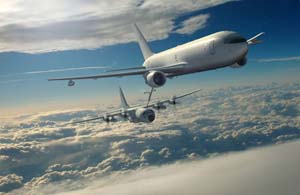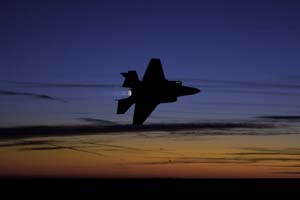At Long Last, Tanker Talk
Ending 18 months of near-silence, Boeing in June began explaining how it will develop and build the KC-46 tanker.
The Air Force awarded Boeing the tanker project in February 2011. Since then, neither the service nor Boeing has been willing to talk much about it, insisting details were being worked out and the time was not yet right to discuss the program.
Now, however, the time is apparently right—probably because the program has passed its preliminary design review.
Maureen Dougherty, Boeing KC-46 program manager, said in an interview the program passed the PDR—a top-level Pentagon review involving acquisition, operational, design, development, and manufacturing considerations—with “flying colors” and with limited issues carried forward for correction. Of 89 areas under question before the review, only eight were still in work afterward, and those were mostly resolved by the end of April, Dougherty said. There were “no surprises,” she asserted.

| ||
| Boeing bets the KC-46 will pay off. (Boeing photo illustration) |
The project now has a firm public timetable. By 2017, Boeing is to deliver 18 aircraft, and ramp up to a production rate of 15 aircraft per year, closing out the 179th airplane in 2027. The “green tail” aircraft will be built on the Boeing 767 production line at Everett, Wash., with the military-specific conversion to be done at nearby Boeing Field. That conversion work was to have been done at Wichita, Kan., but Boeing announced in January it was closing its Wichita facilities to save money.
The next big hurdle is the critical design review, slated for July 2013. By then, the bugs are to have been shaken out of the design, and Boeing can start bending metal. The first flight of the KC-46 will occur in January 2015, with low-rate production to begin later that year. The first production aircraft will be delivered in mid-2016.
Since the award, Boeing has been refining the design and doing all it can to “drive risk from the program,” Dougherty said. A “supplier summit” was held in June 2011 to spell out for vendors just what they had to do to meet the aggressive schedule—and cost—for the tanker. Boeing said that it bid at or below its expected development cost on the program, believing that the increased volume of production and market presence would more than make up for its razor-thin margins on the front end.
“We are ‘leaning out’ the production line,” Dougherty said, “streamlining our processes and … investing in labs” to reduce any concurrency in the program. There are both ground-based and flying laboratories that will focus on various parts of the project to ensure they are ready to go when production hits its stride.
Although the Air Force originally sought a “commercial, off-the-shelf” design, neither Boeing’s KC-767 nor the Airbus KC-45 met all of USAF’s requirements, according to Maj. Gen. Christopher C. Bogdan, the Air Force’s KC-46 program manager. The KC-46 incorporates many changes from both the 767-200ER, on which the airframe is based, and the commercial KC-767, flying with Italy and Japan.
To bridge to the KC-46, Boeing will build and test two hybrid aircraft called 767-2C “Provisioned Freighters” as well as two KC-46 prototypes, Dougherty said. The 2C aircraft will be a 767-200ER, but with larger fuel tanks, a new flight deck, and faired-over holes where the boom equipment, cargo door, self-protection gear, and other equipment will eventually be installed. Ultimately, all four test aircraft will be configured for operational service.
The 2C will integrate and explore the many elements that will come from other aircraft to make the KC-46. It differs from the 767-200ER in having the larger fuel tanks and heavier landing gear, the “provisioned” access places for military-specific equipment and a digital flight deck borrowed from the 787 Dreamliner. While much of the boom-type refueling system is borrowed from the KC-10, the system will be operated by a boom operator located just aft of the cockpit, watching three-dimensional displays of what is going on at the back of the tanker. Wingtip pods can refuel aircraft equipped with a probe-and-drogue-type refueling system—for Navy, Marine Corps, and many allied aircraft—and the centerline can be configured to pass fuel the same way. The aircraft will have substantial self-defense countermeasures.
Additionally, the KC-767 will be more “plugged in” with military networks and offer unprecedented situational awareness for the crew, Dougherty said. This will enable the tanker to be more flexible in meeting pop-up needs, to divert rapidly around weather, and to always operate at the most efficient speeds and altitudes possible.
The aircraft will be able to carry up to 18 standard cargo pallets, or up to 58 passengers or 54 medical evacuees. The proper placement of medical litters was one of the items still to be resolved at the end of the PDR.
“In 16 months, we’ve had no changes to the requirements,” Dougherty said. That’s in keeping with a pledge from senior USAF officials who have vowed not to meddle with requirements, since changes inevitably lead to cost growth.
During the decade-long attempt to launch a replacement tanker, Boeing frequently warned the Air Force that the 767 production line was on the verge of closing due to lack of orders, so if the service wanted a tanker, it should move with alacrity to establish a program.
Since then, however, Boeing “invested in the 767” Dougherty said—in part to keep it a “viable option” for USAF’s tanker needs. Consequently, Federal Express began buying the airplane and there’s now a backlog of orders, she said, without disclosing numbers in Boeing’s order book.
Bogdan said the new “flyaway” unit cost of the KC-46 is $188 million a copy, which does not include development, military construction, or life cycle costs, but does include government furnished equipment such as engines.
Dougherty said she sees “no wavering” on the part of Congress to continue the project, especially since there have been no radical charges of cost growth or mismanagement.
Costs will be closely scrutinized, however, as Boeing has admitted it deliberately low-balled its tanker bid in order to win the contract. Nonetheless, it is the contractor—not the Air Force—that will be responsible for the bulk of any possible cost overruns, and Bogdan asserted that the Air Force “got a great deal” on the project, with “shorter timelines” and “lower cost.”
No Half Measures with the F-35
An almost 10-week strike at Lockheed Martin’s F-35 plant in Fort Worth, Tex., slowed production by about half, said company VP for Aeronautics Larry Lawson. Lockheed brought in salaried workers from its Marietta, Ga., Eglin AFB, Fla., and NAS Patuxent River, Md., facilities to take up some of the slack from the striking machinists. Additionally, some 500 temporary workers were brought in from other parts of the country through labor crisis staffing company PMG, and some employees crossed picket lines. The line went back to work with its full complement of workers after an agreement in late June.
The strike helped cement a decision made by Lockheed and the Joint Strike Fighter program office not to seek efficiencies by building F-35s in same-type lots.
In July 2011, Shay D. Assad, head of the OSD’s “should cost” initiative, agreed that uninterrupted runs of F-35As, Bs, or Cs would theoretically improve the learning curve and speed up production. “That is precisely one of the things we’re examining,” he said.
However, that idea has been dropped, Lawson reported this July.
“It doesn’t help you,” he said.
The line was designed so that workers could build whichever jet was next in the queue, whether that be a conventional takeoff A model, short takeoff and vertical landing B model, or carrier-capable C model. In fact, in July, the sequence of production was different from station to station.
“What we found,” Lawson said, “is that it actually hurt the learning curve if you did a large batch of all one type.” That conclusion was drawn from both computer modeling and simulation as well as experience, when there were several jets in a row of all the same type. A constant mix tended to keep workers mentally limber and fresh as to the proper—and differing—procedures for each variant, Lawson said.

| ||
|
Strike out. (Lockheed Martin photo) |
Given the international nature of the program and the needs of the various services, the ability to switch from variant to variant is necessary, Lawson said. “We are incredibly efficient … at producing at low rates,” he said, and the ability to keep the line running at half speed even during a massive strike was evidence of that.
Nevertheless, Lawson said, the bulk of cost involved in the F-35 is not in final assembly, but with the vendors.
“About 70 percent of the cost is in the supply base,” Lawson said. Part of the supply base is “unique to each variant,” and that’s where Lockheed has been putting a lot of attention on reducing costs.
The biggest cost drivers are glitches in the supply base, which cause a wave effect resulting in line delays, Lawson said.
“If we gap the line, it’s like starting over,” and there are losses in learning curve and efficiency, he said.
As far as cost, Lawson said it continues to be a challenge to get the Pentagon’s cost assessment shop to look at the F-35 on an “apples to apples” basis. The F-35 includes the targeting pod, extra fuel tanks, internal weapons, internal electronic warfare systems, jammers, and other gear that are all “sold separately” on other aircraft, he said.
Nevertheless, there is only a seven percent differential between Lockheed’s cost estimates and the Pentagon’s, he said.
“There’s not a whole lot of debate about it,” Lawson said.